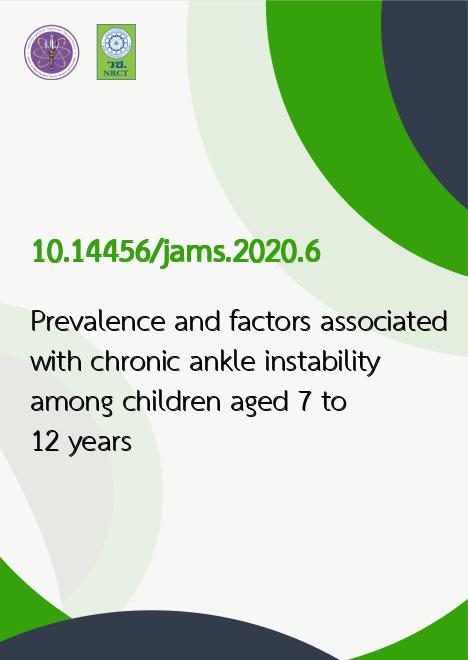
|
Prevalence and factors associated with chronic ankle instability among children aged 7 to 12 years |
|---|---|
| รหัสดีโอไอ | |
| Creator | Raweewan Lekskulchai |
| Title | Prevalence and factors associated with chronic ankle instability among children aged 7 to 12 years |
| Publisher | Faculty of Associated Medical Sciences, Chiang Mai University |
| Publication Year | 2563 |
| Journal Title | Journal of Associated Medical Sciences |
| Journal Vol. | 53 |
| Journal No. | 1 |
| Page no. | 42-48 |
| Keyword | Chronic ankle instability, prevalence, risk factor |
| URL Website | https://www.tci-thaijo.org/index.php/bulletinAMS/index |
| Website title | Journal of Associated Medical Sciences |
| ISSN | 25396056 |
| Abstract | Background: Ankle sprain is the most common cause of chronic ankle instability (CAI). After a sprain, CAI and related components may develop and adversely affect movement performances. Prevalence of CAI in specific groups of children has been reported, however, the prevalence in typical children is lacking. Objective: This study aimed to determine the prevalence of CAI and related components in school-age children. Additionally, factors associated with the components were also examined. Materials and methods: Three hundred and eighty-eight children aged between 7 and 12 years with no past or present serious diseases or disabilities were recruited from normal schools. They were interviewed and assessed to identify CAI components and risk factors. Children with at least one of the 3 components of CAI, including perceived instability (PI), mechanical instability (MI) and recurrent sprain (RS) were recorded as having CAI. Results: The children's mean age was 9.76ฑ1.55 years, and 57% of them were girls. There were 142 children with at least one component of the CAI. Therefore, the prevalence of CAI among the population was 36.60 %. The prevalence of MI, PI and RS were 11.6%, 35.3% and 27.3%, respectively. Significant variables on bivariate analyses (p<0.05) for related components of CAI were overweight, sport participation, living in urban area, moderate degree of initial ankle sprain and poor standing balance in eyes closed condition. After adjusting for the significant variables, overweight (aOR: 1.083, [95%CI: 1.036-1.192], p<0.001) and poor standing balance in eyes closed condition (aOR: 1.142 [95% CI: 1.194-1.311], p<0.001), were associated with RS. Overweight (aOR: 1.229 [95%CI: 1.063-2.264], p<0.001), sport participation (aOR: 1.192 [95%CI: 1.052-3.308], p=0.013), moderate ankle sprain (aOR: 1.143 [95%CI: 1.038-3.541], p=0.004) and poor standing balance in eyes closed condition (aOR: 3.476 [95% CI: 1.872- 6.453], p=0.006) were associated with PI. Moderate ankle sprain (aOR: 1.099 [95%CI: 1.027-4.370], p<0.001), and poor standing balance in eyes closed condition (aOR: 4.251 [95% CI: 1.248- 14.485] p=0.021) were associated with MI. Conclusion: CAI and related components were existed among typical school-age children. The risk of all CAI components was high in children with poor standing balance. Overweight children were at higher risk of RS and PI. Children with moderate degree of ankle sprain were at higher risk for developing PI and MI. Further studies are recommended to develop preventive managements for this population. |